
Crystal habit
Encyclopedia
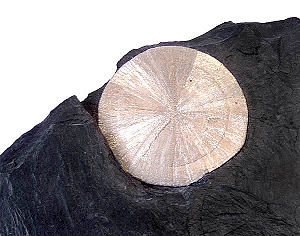
In mineralogy
Mineralogy
Mineralogy is the study of chemistry, crystal structure, and physical properties of minerals. Specific studies within mineralogy include the processes of mineral origin and formation, classification of minerals, their geographical distribution, as well as their utilization.-History:Early writing...
, shape and size give rise to descriptive terms applied to the typical appearance, or habit of crystal
Crystal
A crystal or crystalline solid is a solid material whose constituent atoms, molecules, or ions are arranged in an orderly repeating pattern extending in all three spatial dimensions. The scientific study of crystals and crystal formation is known as crystallography...
s. Each crystal can be described by how well it is formed, ranging from euhedral
Euhedral
Euhedral crystals are those that are well-formed with sharp, easily recognised faces. Normally, crystals do not form smooth faces or sharp crystal outlines. Many crystals grow from cooling liquid magma...
(perfect to near-perfect), to subhedral (moderately formed), and anhedral (poorly formed to no discernable habit seen).
The many terms used by mineralogists to describe crystal habits are useful in communicating what specimens of a particular mineral
Mineral
A mineral is a naturally occurring solid chemical substance formed through biogeochemical processes, having characteristic chemical composition, highly ordered atomic structure, and specific physical properties. By comparison, a rock is an aggregate of minerals and/or mineraloids and does not...
often look like. Recognizing numerous habits helps a mineralogist to identify a large number of minerals. Some habits are distinctive of certain minerals, although most minerals exhibit many differing habits (the development of a particular habit is determined by the details of the conditions during the mineral formation/crystal growth). Crystal habit may mislead the inexperienced as a mineral's internal crystal system
Crystal structure
In mineralogy and crystallography, crystal structure is a unique arrangement of atoms or molecules in a crystalline liquid or solid. A crystal structure is composed of a pattern, a set of atoms arranged in a particular way, and a lattice exhibiting long-range order and symmetry...
can be hidden or disguised.
Factors influencing a crystal's habit include: a combination of two or more crystal forms; trace impurities present during growth; crystal twinning
Crystal twinning
Crystal twinning occurs when two separate crystals share some of the same crystal lattice points in a symmetrical manner. The result is an intergrowth of two separate crystals in a variety of specific configurations. A twin boundary or composition surface separates the two crystals....
and growth conditions (i.e., heat, pressure, space); and specific growth tendencies like growth striations
Striation (geology)
In geology, a striation means linear furrows generated from fault movement; The striation's direction reveal the movement directions in the fault plane. Similar striations can occur with glaciation....
. Minerals belonging to the same crystal system do not necessarily exhibit the same habit. Some habits of a mineral are unique to its variety and locality: For example, while most sapphire
Sapphire
Sapphire is a gemstone variety of the mineral corundum, an aluminium oxide , when it is a color other than red or dark pink; in which case the gem would instead be called a ruby, considered to be a different gemstone. Trace amounts of other elements such as iron, titanium, or chromium can give...
s form elongate barrel-shaped crystals, those found in Montana
Montana
Montana is a state in the Western United States. The western third of Montana contains numerous mountain ranges. Smaller, "island ranges" are found in the central third of the state, for a total of 77 named ranges of the Rocky Mountains. This geographical fact is reflected in the state's name,...
form stout tabular crystals. Ordinarily, the latter habit is seen only in ruby
Ruby
A ruby is a pink to blood-red colored gemstone, a variety of the mineral corundum . The red color is caused mainly by the presence of the element chromium. Its name comes from ruber, Latin for red. Other varieties of gem-quality corundum are called sapphires...
. Sapphire and ruby are both varieties of the same mineral; corundum
Corundum
Corundum is a crystalline form of aluminium oxide with traces of iron, titanium and chromium. It is a rock-forming mineral. It is one of the naturally clear transparent materials, but can have different colors when impurities are present. Transparent specimens are used as gems, called ruby if red...
.
Some minerals may replace other existing minerals while preserving the original's habit: this process is called pseudomorphous replacement
Pseudomorph
In mineralogy, a pseudomorph is a mineral or mineral compound that appears in an atypical form , resulting from a substitution process in which the appearance and dimensions remain constant, but the original mineral is replaced by another...
. A classic example is tiger's eye
Tiger's eye
Tiger's eye is a chatoyant gemstone that is usually a metamorphic rock that is a golden to red-brown color, with a silky luster. A member of the quartz group, it is a classic example of pseudomorphous replacement by silica of fibrous crocidolite...
quartz
Quartz
Quartz is the second-most-abundant mineral in the Earth's continental crust, after feldspar. It is made up of a continuous framework of SiO4 silicon–oxygen tetrahedra, with each oxygen being shared between two tetrahedra, giving an overall formula SiO2. There are many different varieties of quartz,...
, crocidolite asbestos
Asbestos
Asbestos is a set of six naturally occurring silicate minerals used commercially for their desirable physical properties. They all have in common their eponymous, asbestiform habit: long, thin fibrous crystals...
replaced by silica. While quartz typically forms prismatic (elongate, prism-like) crystals, in tiger's eye the original fibrous habit of crocidolite is preserved.
The names of crystal habits are derived from:
Predominant crystal faces (prism - prismatic, pyramid - pyramidal and pinacoid - platy).
Crystal forms (cubic, octahedral, dodecahedral).
Aggregation of crystals or aggregates (fibrous, botryoidal, radiating, massive).
Crystal appearance (foliated/lamellar (layered), dendritic, bladed, acicular, lenticular, tabular (tablet shaped)).
List of crystal habits
| Habit | Image | Description | Common Example(s) |
|---|---|---|---|
| Acicular Acicular (crystal habit) Acicular, in mineralogy, refers to a crystal habit composed of a radiating mass of slender, needle-like crystals. Minerals with this habit tend to be fragile and complete, undamaged specimens can be uncommon.-Examples:... |
Needle-like, slender and/or tapered | Natrolite Natrolite Natrolite is a tectosilicate mineral species belonging to the zeolite group. It is a hydrated sodium and aluminium silicate with the formula . The type locality is Hohentwiel, Hegau, Germany.... , Rutile Rutile Rutile is a mineral composed primarily of titanium dioxide, TiO2.Rutile is the most common natural form of TiO2. Two rarer polymorphs of TiO2 are known:... |
|
| Amygdaloidal | Almond-shaped | Heulandite Heulandite Heulandite is the name of a series of tecto-silicate minerals of the zeolite group. Prior to 1997, heulandite was recognized as a mineral species, but a reclassification in 1997 by the International Mineralogical Association changed it to a series name, with the mineral species being named:*... , subhedral Zircon Zircon Zircon is a mineral belonging to the group of nesosilicates. Its chemical name is zirconium silicate and its corresponding chemical formula is ZrSiO4. A common empirical formula showing some of the range of substitution in zircon is 1–x4x–y... |
|
| Bladed | Blade-like, slender and flattened | Actinolite Actinolite Actinolite is an amphibole silicate mineral with the chemical formula .-Etymology:The name actinolite is derived from the Greek word aktis , meaning "beam" or "ray", because of the mineral's fibrous nature... , Kyanite Kyanite Kyanite, whose name derives from the Greek word kuanos sometimes referred to as "kyanos", meaning deep blue, is a typically blue silicate mineral, commonly found in aluminium-rich metamorphic pegmatites and/or sedimentary rock. Kyanite in metamorphic rocks generally indicates pressures higher than... |
|
| Botryoidal Botryoidal A botryoidal texture or mineral habit is one in which the mineral has a globular external form resembling a bunch of grapes as derived from the Greek. This is a common form for many minerals particularly hematite where it is the classically recognized shape. It is also a common form of goethite,... or globular |
 |
Grape-like, hemispherical masses | Hematite Hematite Hematite, also spelled as haematite, is the mineral form of iron oxide , one of several iron oxides. Hematite crystallizes in the rhombohedral system, and it has the same crystal structure as ilmenite and corundum... , Pyrite Pyrite The mineral pyrite, or iron pyrite, is an iron sulfide with the formula FeS2. This mineral's metallic luster and pale-to-normal, brass-yellow hue have earned it the nickname fool's gold because of its resemblance to gold... , Malachite Malachite Malachite is a copper carbonate mineral, with the formula Cu2CO32. This green-colored mineral crystallizes in the monoclinic crystal system, and most often forms botryoidal, fibrous, or stalagmitic masses. Individual crystals are rare but do occur as slender to acicular prisms... , Smithsonite Smithsonite Smithsonite, or zinc spar, is zinc carbonate , a mineral ore of zinc. Historically, smithsonite was identified with hemimorphite before it was realised that they were two distinct minerals. The two minerals are very similar in appearance and the term calamine has been used for both, leading to some... , Hemimorphite Hemimorphite Hemimorphite, is a sorosilicate mineral which has been mined from days of old from the upper parts of zinc and lead ores, chiefly associated with smithsonite. It was often assumed to be the same mineral and both were classed under the same name of calamine... , Adamite Adamite Adamite is a zinc arsenate hydroxide mineral, Zn2AsO4OH. It is a mineral that typically occurs in the oxidized or weathered zone above zinc ore occurrences. Pure adamite is colorless, but usually it possess yellow color due to Fe compounds admixture. Tints of green also occur and are connected with... , Variscite Variscite Variscite is a hydrated aluminium phosphate mineral |H2O]]). It is a relatively rare phosphate mineral. It is sometimes confused with turquoise; however, variscite is usually greener in color.... |
| Columnar | Similar to fibrous: Long, slender prisms often with parallel growth | Calcite Calcite Calcite is a carbonate mineral and the most stable polymorph of calcium carbonate . The other polymorphs are the minerals aragonite and vaterite. Aragonite will change to calcite at 380-470°C, and vaterite is even less stable.-Properties:... , Gypsum Gypsum Gypsum is a very soft sulfate mineral composed of calcium sulfate dihydrate, with the chemical formula CaSO4·2H2O. It is found in alabaster, a decorative stone used in Ancient Egypt. It is the second softest mineral on the Mohs Hardness Scale... /Selenite |
|
| Coxcomb | Aggregated flaky or tabular crystals closely spaced. | Barite Barite Baryte, or barite, is a mineral consisting of barium sulfate. The baryte group consists of baryte, celestine, anglesite and anhydrite. Baryte itself is generally white or colorless, and is the main source of barium... , Marcasite Marcasite The mineral marcasite, sometimes called white iron pyrite, is iron sulfide with orthorhombic crystal structure. It is physically and crystallographically distinct from pyrite, which is iron sulfide with cubic crystal structure. Both structures do have in common that they contain the disulfide... |
|
| Cubic | Cube Cube In geometry, a cube is a three-dimensional solid object bounded by six square faces, facets or sides, with three meeting at each vertex. The cube can also be called a regular hexahedron and is one of the five Platonic solids. It is a special kind of square prism, of rectangular parallelepiped and... shape |
Pyrite Pyrite The mineral pyrite, or iron pyrite, is an iron sulfide with the formula FeS2. This mineral's metallic luster and pale-to-normal, brass-yellow hue have earned it the nickname fool's gold because of its resemblance to gold... , Galena Galena Galena is the natural mineral form of lead sulfide. It is the most important lead ore mineral.Galena is one of the most abundant and widely distributed sulfide minerals. It crystallizes in the cubic crystal system often showing octahedral forms... , Halite Halite Halite , commonly known as rock salt, is the mineral form of sodium chloride . Halite forms isometric crystals. The mineral is typically colorless or white, but may also be light blue, dark blue, purple, pink, red, orange, yellow or gray depending on the amount and type of impurities... |
|
| Dendritic or arborescent | Tree-like, branching in one or more direction from central point | Pyrolusite Pyrolusite Pyrolusite is a mineral consisting essentially of manganese dioxide and is important as an ore of manganese. It is a black, amorphous appearing mineral, often with a granular, fibrous or columnar structure, sometimes forming reniform crusts. It has a metallic luster, a black or bluish-black... and other Mn Manganese Manganese is a chemical element, designated by the symbol Mn. It has the atomic number 25. It is found as a free element in nature , and in many minerals... -oxide minerals, Magnesite Magnesite Magnesite is magnesium carbonate, MgCO3. Iron substitutes for magnesium with a complete solution series with siderite, FeCO3. Calcium, manganese, cobalt, and nickel may also occur in small amounts... , native copper Copper Copper is a chemical element with the symbol Cu and atomic number 29. It is a ductile metal with very high thermal and electrical conductivity. Pure copper is soft and malleable; an exposed surface has a reddish-orange tarnish... |
|
| Dodecahedral | 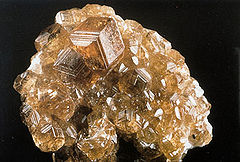 |
Dodecahedron, 12-sided | Garnet Garnet The garnet group includes a group of minerals that have been used since the Bronze Age as gemstones and abrasives. The name "garnet" may come from either the Middle English word gernet meaning 'dark red', or the Latin granatus , possibly a reference to the Punica granatum , a plant with red seeds... |
| Drusy Druse (geology) In geological usage druse or druzy is a coating of fine crystals on a rock fracture surface, vein or within a vug or geode.- Occurrence :Druse occurs worldwide, the most common is perhaps quartz druse within voids in chert or agates... or encrustation |
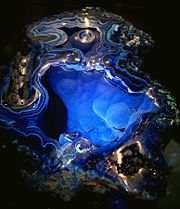 |
Aggregate of minute crystals coating a surface or cavity | Uvarovite Uvarovite Uvarovite is a chromium-bearing garnet group species with the formula: Ca3Cr23. It was discovered in 1832 by Germain Henri Hess who named it after Count Sergei Semenovitch Uvarov , a Russian statesman and amateur mineral collector.... , Malachite Malachite Malachite is a copper carbonate mineral, with the formula Cu2CO32. This green-colored mineral crystallizes in the monoclinic crystal system, and most often forms botryoidal, fibrous, or stalagmitic masses. Individual crystals are rare but do occur as slender to acicular prisms... , Azurite Azurite Azurite is a soft, deep blue copper mineral produced by weathering of copper ore deposits. It is also known as Chessylite after the type locality at Chessy-les-Mines near Lyon, France... |
| Enantiomorphic | Mirror-image habit (i.e. crystal twinning Crystal twinning Crystal twinning occurs when two separate crystals share some of the same crystal lattice points in a symmetrical manner. The result is an intergrowth of two separate crystals in a variety of specific configurations. A twin boundary or composition surface separates the two crystals.... ) and optical characteristics; right- and left-handed crystals |
Quartz Quartz Quartz is the second-most-abundant mineral in the Earth's continental crust, after feldspar. It is made up of a continuous framework of SiO4 silicon–oxygen tetrahedra, with each oxygen being shared between two tetrahedra, giving an overall formula SiO2. There are many different varieties of quartz,... , Plagioclase Plagioclase Plagioclase is an important series of tectosilicate minerals within the feldspar family. Rather than referring to a particular mineral with a specific chemical composition, plagioclase is a solid solution series, more properly known as the plagioclase feldspar series... , Staurolite Staurolite Staurolite is a red brown to black, mostly opaque, nesosilicate mineral with a white streak.-Properties:It crystallizes in the monoclinic crystal system, has a Mohs hardness of 7 to 7.5 and a rather complex chemical formula: 2Al94O204... |
|
| Equant, stout | 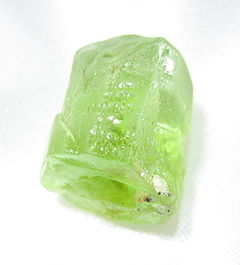 |
Length, width, and breadth roughly equal | Olivine Olivine The mineral olivine is a magnesium iron silicate with the formula 2SiO4. It is a common mineral in the Earth's subsurface but weathers quickly on the surface.... , Garnet Garnet The garnet group includes a group of minerals that have been used since the Bronze Age as gemstones and abrasives. The name "garnet" may come from either the Middle English word gernet meaning 'dark red', or the Latin granatus , possibly a reference to the Punica granatum , a plant with red seeds... |
| Fibrous | Extremely slender prisms | Serpentine group, Tremolite Tremolite Tremolite is a member of the amphibole group of silicate minerals with composition: Ca2Mg5Si8O222. Tremolite forms by metamorphism of sediments rich in dolomite and quartz. Tremolite forms a series with actinolite and ferro-actinolite. Pure magnesium tremolite is creamy white, but the color grades... (i.e. Asbestos Asbestos Asbestos is a set of six naturally occurring silicate minerals used commercially for their desirable physical properties. They all have in common their eponymous, asbestiform habit: long, thin fibrous crystals... ) |
|
| Filiform or capillary | Hair-like or thread-like, extremely fine | many Zeolite Zeolite Zeolites are microporous, aluminosilicate minerals commonly used as commercial adsorbents. The term zeolite was originally coined in 1756 by Swedish mineralogist Axel Fredrik Cronstedt, who observed that upon rapidly heating the material stilbite, it produced large amounts of steam from water that... s |
|
| Foliated or micaceous or lamellar (layered) | Layered structure, parting into thin sheets | Mica Mica The mica group of sheet silicate minerals includes several closely related materials having highly perfect basal cleavage. All are monoclinic, with a tendency towards pseudohexagonal crystals, and are similar in chemical composition... (Muscovite Muscovite Muscovite is a phyllosilicate mineral of aluminium and potassium with formula KAl22, or 236. It has a highly-perfect basal cleavage yielding remarkably-thin laminæ which are often highly elastic... , Biotite Biotite Biotite is a common phyllosilicate mineral within the mica group, with the approximate chemical formula . More generally, it refers to the dark mica series, primarily a solid-solution series between the iron-endmember annite, and the magnesium-endmember phlogopite; more aluminous endmembers... , etc.) |
|
| Granular | 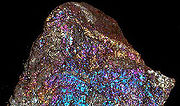 |
Aggregates of anhedral crystals in matrix | Bornite Bornite Bornite is a sulfide mineral with chemical composition Cu5FeS4 that crystallizes in the orthorhombic system .-Appearance:Bornite has a brown to copper-red color on fresh surfaces that tarnishes to various iridescent shades of blue to purple in places... , Scheelite Scheelite Scheelite is a calcium tungstate mineral with the chemical formula CaWO4. It is an important ore of tungsten. Well-formed crystals are sought by collectors and are occasionally fashioned into gemstones when suitably free of flaws... |
| Hemimorphic | Doubly terminated crystal with two differently shaped ends. | Hemimorphite Hemimorphite Hemimorphite, is a sorosilicate mineral which has been mined from days of old from the upper parts of zinc and lead ores, chiefly associated with smithsonite. It was often assumed to be the same mineral and both were classed under the same name of calamine... , Elbaite Elbaite Elbaite, a sodium, lithium, aluminium boro-silicate, is a mineral species belonging to the tourmaline group. Elbaite forms three series, with dravite, with liddicoatite, and with schorl... |
|
| Hexagonal | Hexagon shape, six-sided | Quartz Quartz Quartz is the second-most-abundant mineral in the Earth's continental crust, after feldspar. It is made up of a continuous framework of SiO4 silicon–oxygen tetrahedra, with each oxygen being shared between two tetrahedra, giving an overall formula SiO2. There are many different varieties of quartz,... , Hanksite Hanksite Hanksite is a sulfate mineral, distinguished as one of only a handful that contain both carbonate and sulfate ion groups. It has the chemical formula: Na22K92Cl.-Occurrence:... |
|
| Hopper crystals | 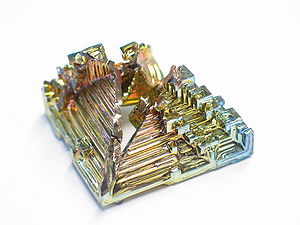 |
Like cubic, but outer portions of cubes grow faster than inner portions, creating a concavity | Halite Halite Halite , commonly known as rock salt, is the mineral form of sodium chloride . Halite forms isometric crystals. The mineral is typically colorless or white, but may also be light blue, dark blue, purple, pink, red, orange, yellow or gray depending on the amount and type of impurities... , Calcite Calcite Calcite is a carbonate mineral and the most stable polymorph of calcium carbonate . The other polymorphs are the minerals aragonite and vaterite. Aragonite will change to calcite at 380-470°C, and vaterite is even less stable.-Properties:... , synthetic Bismuth Bismuth Bismuth is a chemical element with symbol Bi and atomic number 83. Bismuth, a trivalent poor metal, chemically resembles arsenic and antimony. Elemental bismuth may occur naturally uncombined, although its sulfide and oxide form important commercial ores. The free element is 86% as dense as lead... |
| Mamillary | Breast-like: surface formed by intersecting partial spherical shapes, larger version of botryoidal, also concentric layered aggregates | Malachite Malachite Malachite is a copper carbonate mineral, with the formula Cu2CO32. This green-colored mineral crystallizes in the monoclinic crystal system, and most often forms botryoidal, fibrous, or stalagmitic masses. Individual crystals are rare but do occur as slender to acicular prisms... , Hematite Hematite Hematite, also spelled as haematite, is the mineral form of iron oxide , one of several iron oxides. Hematite crystallizes in the rhombohedral system, and it has the same crystal structure as ilmenite and corundum... |
|
| Massive or compact |  |
Shapeless, no distinctive external crystal shape | Limonite Limonite Limonite is an ore consisting in a mixture of hydrated iron oxide-hydroxide of varying composition. The generic formula is frequently written as FeO·nH2O, although this is not entirely accurate as limonite often contains a varying amount of oxide compared to hydroxide.Together with hematite, it has... , Turquoise Turquoise Turquoise is an opaque, blue-to-green mineral that is a hydrous phosphate of copper and aluminium, with the chemical formula CuAl648·4. It is rare and valuable in finer grades and has been prized as a gem and ornamental stone for thousands of years owing to its unique hue... , Cinnabar Cinnabar Cinnabar or cinnabarite , is the common ore of mercury.-Word origin:The name comes from κινναβαρι , a Greek word most likely applied by Theophrastus to several distinct substances... , Realgar Realgar Realgar, α-As4S4, is an arsenic sulfide mineral, also known as "ruby sulphur" or "ruby of arsenic". It is a soft, sectile mineral occurring in monoclinic crystals, or in granular, compact, or powdery form, often in association with the related mineral, orpiment . It is orange-red in colour, melts... |
| Nodular or tuberose |  |
Deposit of roughly spherical form with irregular protuberances | Chalcedony Chalcedony Chalcedony is a cryptocrystalline form of silica, composed of very fine intergrowths of the minerals quartz and moganite. These are both silica minerals, but they differ in that quartz has a trigonal crystal structure, while moganite is monoclinic... , various Geode Geode Geodes are geological secondary sedimentary structures which occur in sedimentary and certain volcanic rocks. Geodes are essentially spherical masses of mineral matter that were deposited sygenetically within the rock formations they are found in. Geodes have a Chalcedony shell containing... s |
| Octahedral | 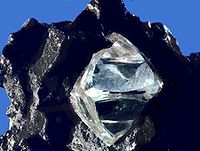 |
Octahedron Octahedron In geometry, an octahedron is a polyhedron with eight faces. A regular octahedron is a Platonic solid composed of eight equilateral triangles, four of which meet at each vertex.... , eight-sided (two pyramids base to base) |
Diamond Diamond In mineralogy, diamond is an allotrope of carbon, where the carbon atoms are arranged in a variation of the face-centered cubic crystal structure called a diamond lattice. Diamond is less stable than graphite, but the conversion rate from diamond to graphite is negligible at ambient conditions... , Magnetite Magnetite Magnetite is a ferrimagnetic mineral with chemical formula Fe3O4, one of several iron oxides and a member of the spinel group. The chemical IUPAC name is iron oxide and the common chemical name is ferrous-ferric oxide. The formula for magnetite may also be written as FeO·Fe2O3, which is one part... |
| Plumose | Fine, feather-like scales | Aurichalcite Aurichalcite Aurichalcite is a carbonate mineral, usually found as a secondary mineral in copper and zinc deposits. Its chemical formula is 526... , Boulangerite Boulangerite Boulangerite is a sulfosalt mineral, lead antimony sulfide, formula Pb5Sb4S11. It was named in 1837 in honor of French mining engineer Charles Boulanger. It forms metallic grey monoclinic crystals. Sometimes the crystals form a fine feathery mass which has been called plumosite.... , Mottramite Mottramite Mottramite is an orthorhombic mineral, PbCu, at the copper end of the descloizite group. It was formerly called cuprodescloizite or psittacinite .-References:***... |
|
| Prismatic | 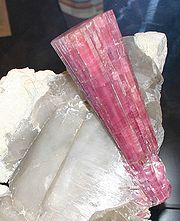 |
Elongate, prism-like, semi-cylidrical: crystal faces parallel to c-axis well-developed | Tourmaline Tourmaline Tourmaline is a crystal boron silicate mineral compounded with elements such as aluminium, iron, magnesium, sodium, lithium, or potassium. Tourmaline is classified as a semi-precious stone and the gem comes in a wide variety of colors... , Beryl Beryl The mineral beryl is a beryllium aluminium cyclosilicate with the chemical formula Be3Al26. The hexagonal crystals of beryl may be very small or range to several meters in size. Terminated crystals are relatively rare... |
| Pseudo-hexagonal | Hexagonal appearance due to cyclic twinning | Aragonite Aragonite Aragonite is a carbonate mineral, one of the two common, naturally occurring, crystal forms of calcium carbonate, CaCO3... , Chrysoberyl Chrysoberyl The mineral or gemstone chrysoberyl is an aluminate of beryllium with the formula BeAl2O4. The name chrysoberyl is derived from the Greek words χρυσός chrysos and βήρυλλος beryllos, meaning "a gold-white spar". Despite the similarity of their names, chrysoberyl and beryl are two completely... |
|
| Radiating or divergent | Radiating outward from a central point | Wavellite Wavellite Wavellite is a phosphate mineral with formula Al323·5H2O.It normally occurs as translucent green radial or spherical clusters.-Discovery and occurrence:... , Pyrite Pyrite The mineral pyrite, or iron pyrite, is an iron sulfide with the formula FeS2. This mineral's metallic luster and pale-to-normal, brass-yellow hue have earned it the nickname fool's gold because of its resemblance to gold... suns |
|
| Reniform or colloform | Similar to botryoidal/mamillary: intersecting kidney-shaped masses | Hematite Hematite Hematite, also spelled as haematite, is the mineral form of iron oxide , one of several iron oxides. Hematite crystallizes in the rhombohedral system, and it has the same crystal structure as ilmenite and corundum... , Pyrolusite Pyrolusite Pyrolusite is a mineral consisting essentially of manganese dioxide and is important as an ore of manganese. It is a black, amorphous appearing mineral, often with a granular, fibrous or columnar structure, sometimes forming reniform crusts. It has a metallic luster, a black or bluish-black... , Greenockite Greenockite Greenockite is a rare cadmium mineral that consists of cadmium sulfide, CdS, in crystalline form. Greenockite crystallizes in the hexagonal system. It occurs as massive encrustations and as six-sided pyramidal crystals which vary in color from a honey yellow through shades of red to brown... |
|
| Reticulated | Crystals forming net-like intergrowths | Cerussite Cerussite Cerussite is a mineral consisting of lead carbonate , and an important ore of lead. The name is from the Latin cerussa, white lead. Cerussa nativa was mentioned by Conrad Gessner in 1565, and in 1832 F. S. Beudant applied the name cruse to the mineral, whilst the present form, cerussite, is due to... |
|
| Rosette or lenticular (lens shaped crystals) | Platy, radiating rose-like aggregate | Gypsum Gypsum Gypsum is a very soft sulfate mineral composed of calcium sulfate dihydrate, with the chemical formula CaSO4·2H2O. It is found in alabaster, a decorative stone used in Ancient Egypt. It is the second softest mineral on the Mohs Hardness Scale... , Barite Barite Baryte, or barite, is a mineral consisting of barium sulfate. The baryte group consists of baryte, celestine, anglesite and anhydrite. Baryte itself is generally white or colorless, and is the main source of barium... (i.e. Desert rose Desert rose (crystal) thumb|right|250px|Saharan desert rose, 47 cm long.Desert rose is the colloquial name given to rosette formations of the minerals gypsum and barite with poikilotopic sand inclusions... ) |
|
| Sphenoid | Wedge-shaped | Sphene | |
| Stalactitic | 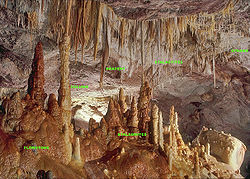 |
Forming as stalactites or stalagmites; cylindrical or cone-shaped | Calcite Calcite Calcite is a carbonate mineral and the most stable polymorph of calcium carbonate . The other polymorphs are the minerals aragonite and vaterite. Aragonite will change to calcite at 380-470°C, and vaterite is even less stable.-Properties:... , Goethite Goethite Goethite , named after the German polymath Johann Wolfgang von Goethe, is an iron bearing oxide mineral found in soil and other low-temperature environments. Goethite has been well known since prehistoric times for its use as a pigment. Evidence has been found of its use in paint pigment samples... |
| Stellate | Star-like, radiating | Pyrophyllite Pyrophyllite Pyrophyllite is a phyllosilicate mineral composed of aluminium silicate hydroxide: Al2Si4O102. It occurs in two more or less distinct varieties, namely, as crystalline folia and as compact masses; distinct crystals are not known.... , Aragonite Aragonite Aragonite is a carbonate mineral, one of the two common, naturally occurring, crystal forms of calcium carbonate, CaCO3... |
|
| Striated Striation (geology) In geology, a striation means linear furrows generated from fault movement; The striation's direction reveal the movement directions in the fault plane. Similar striations can occur with glaciation.... |
 |
Not a habit per se, but a condition of lines that can grow on certain crystal faces on certain minerals | Tourmaline Tourmaline Tourmaline is a crystal boron silicate mineral compounded with elements such as aluminium, iron, magnesium, sodium, lithium, or potassium. Tourmaline is classified as a semi-precious stone and the gem comes in a wide variety of colors... , Pyrite Pyrite The mineral pyrite, or iron pyrite, is an iron sulfide with the formula FeS2. This mineral's metallic luster and pale-to-normal, brass-yellow hue have earned it the nickname fool's gold because of its resemblance to gold... , Quartz Quartz Quartz is the second-most-abundant mineral in the Earth's continental crust, after feldspar. It is made up of a continuous framework of SiO4 silicon–oxygen tetrahedra, with each oxygen being shared between two tetrahedra, giving an overall formula SiO2. There are many different varieties of quartz,... , Feldspar Feldspar Feldspars are a group of rock-forming tectosilicate minerals which make up as much as 60% of the Earth's crust.... , Sphalerite Sphalerite Sphalerite is a mineral that is the chief ore of zinc. It consists largely of zinc sulfide in crystalline form but almost always contains variable iron. When iron content is high it is an opaque black variety, marmatite. It is usually found in association with galena, pyrite, and other sulfides... |
| Stubby or blocky or tabular | More elongated than equant, slightly longer than wide, flat tablet shaped | Feldspar Feldspar Feldspars are a group of rock-forming tectosilicate minerals which make up as much as 60% of the Earth's crust.... , Topaz Topaz Topaz is a silicate mineral of aluminium and fluorine with the chemical formula Al2SiO42. Topaz crystallizes in the orthorhombic system and its crystals are mostly prismatic terminated by pyramidal and other faces.-Color and varieties:... |
|
| Platy | 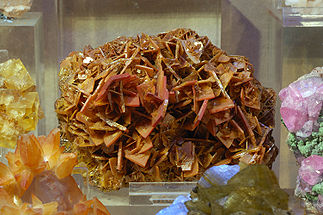 |
Flat, tablet-shaped, prominent pinnacoid | Wulfenite Wulfenite Wulfenite is a lead molybdate mineral with the formula PbMoO4. It can be most often found as thin tabular crystals with a bright orange-red to yellow-orange color, sometimes brown, although the color can be highly variable. In its yellow form it is sometimes called "yellow lead ore".It crystallizes... |
| Tetrahedral | Tetrahedra-shaped crystals | Tetrahedrite Tetrahedrite Tetrahedrite is a copper antimony sulfosalt mineral with formula: 12Sb4S13. It is the antimony endmember of the continuous solid solution series with arsenic bearing tennantite. Pure endmembers of the series are seldom if ever seen in nature. Of the two, the antimony rich phase is more common... , Spinel Spinel Spinel is the magnesium aluminium member of the larger spinel group of minerals. It has the formula MgAl2O4. Balas ruby is an old name for a rose-tinted variety.-Spinel group:... , Magnetite Magnetite Magnetite is a ferrimagnetic mineral with chemical formula Fe3O4, one of several iron oxides and a member of the spinel group. The chemical IUPAC name is iron oxide and the common chemical name is ferrous-ferric oxide. The formula for magnetite may also be written as FeO·Fe2O3, which is one part... |
|
| Wheat sheaf | Aggregates resembling hand-reaped wheat sheaves | Stilbite Stilbite Stilbite is the name of a series of tectosilicate minerals of the zeolite group. Prior to 1997, stilbite was recognized as a mineral species, but a reclassification in 1997 by the International Mineralogical Association changed it to a series name, with the mineral species being named:*... |

